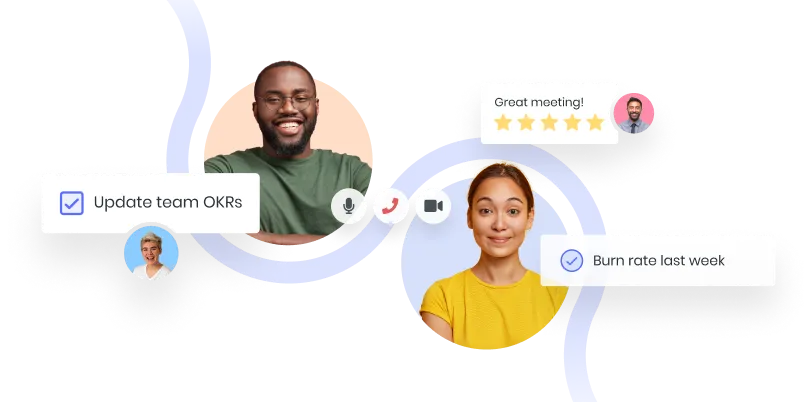%2520crop.png)

Kick-off the meeting
Ask your team member about the highlight of their week (this doesn't need to be restricted to work; anything will do)
Read your team member's prepared update in silence
Have your teammate create an update prior to the meeting. The update should:
- Center around their OKRs for the month/quarter/year. Split into 'what went well', and 'what could improve' sections around each objective
- Track progress towards their KPI's
- Summary of any pertinent information about how their goals have gone. e.g. What new information did you gather about the customer? The product?
Go through your team member's issues (and proposed solutions)
Try to keep to a few minutes for each issue and not get bogged down in minutiae. For clear asks, give an immediate response or create a follow-up task. Otherwise, we recommend helping people come to their own conclusions, it'll foster a sense of healthy independence.
Cover any open-ended discussions (time for blue-sky thinking)
Prompt your report to create topics prior to the meeting.
Ask, "what are your three most important things to get done by this time next week/month"
Preferably whatever they come up with should be related to their OKR's. Jot down the three tasks in your project management system, set the owner, and the due date for the next one-on-one.
Feedback
Be extremely candid and clear with your critical feedback, leave no room for interpretation. Make sure to give both positive and negative feedback.
High-five
This seals any commitments and parts of the meeting with a good note.
With all the distractions of work, it can be easy to get sucked into projects, problems, and challenges without thinking about the people behind that work. One-on-one meetings are an opportunity to take a step back to talk about how the work is getting done instead.
This is a meeting between just a manager and employee, free from a team meetings’ politics and distractions.
How often should you have one-on-one meetings?
Some managers prefer to have one-on-ones weekly or bi-weekly. For others, it’s monthly or quarterly. What meeting cadence you choose will have as much to do with personal style as it does with how often you interact together. This one-on-one meeting agenda template should work regardless of how frequently you have your one-on-ones.
Why it’s important to have hard conversations more often
Giving critical feedback can be difficult and uncomfortable. Many managers shy away from addressing issues, which causes them to build up. Then, at the end of the year, you have a disastrous annual performance review with too many surprises.
Instead of letting performance issues languish, more frequent one-on-ones provide an opportunity to talk about challenges in a less-stressful environment. Meeting one-on-one more frequently will give employees a clear picture of how their performance is going in between review cycles. They’ll know what they can do to improve.
You’ll see in this one-on-one meeting template to “not get bogged down in minutiae” during the issues and solutions part of the meeting. While it’s essential to address issues as they arise, you don’t need to dwell on problems or split hairs.
How to give feedback in a one-on-one meeting
There's a simple way of communicating feedback that avoids provoking anger and defensiveness. Simply communicate in the following format: "When you do a specific action, I feel [emotion] because [story/reason]. My request is …, can you do that for me?"
Feedback should be in the like that/wish that format:
- Like that… Say what did you like about the team member’s actions since the previous meeting? Be specific. During the week, actively look for actions to compliment
- Wish that… What do you wish would change? Be as specific and vulnerable as possible. We recommend using the format detailed above
- It's required that... behavior that needs to change/improve. Otherwise the next step is a performance improvement plan
Notice that all of these comments are about the behavior, not the person. Always refrain from personal attacks.
One-on-ones aren’t just about addressing performance issues
Just as important as it is to talk about areas of improvement in your one-on-ones, as you'll see in this one-on-one meeting agenda template, there is a myriad of other conversations that should be part of some or all these meetings:
- Blue-sky thinking for big ideas
- Feedback for the manager
- Skills, training, or equipment needs
- Career aspirations and how to help an employee reach them
If you’re a manager, this is a time to focus on your employee and how you can help them the most.

.png)


.png)




